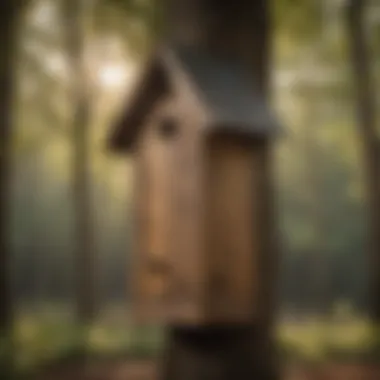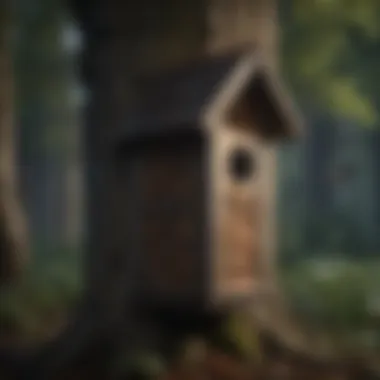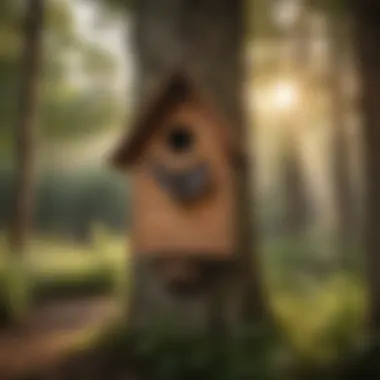Unlocking the Eco-Friendly Advantages of Installing a Bat House on Your Property


Evergreen Trees Species
Evergreen trees play a vital role in the ecosystem, particularly in American forests. These trees maintain their foliage year-round, offering numerous benefits that go beyond their aesthetic appeal. Species such as pine, fir, and spruce dominate the evergreen landscape, contributing to the biodiversity and ecological balance of forested areas.
Types of Evergreen Trees
American forests boast a diverse array of evergreen species, each with unique characteristics and habitats. From the towering redwoods of the West Coast to the adaptable white pines of the Northeast, exploring the rich tapestry of evergreen trees provides insights into the resilience and adaptability of these important flora.
Ecological Significance
The ecological significance of evergreen trees cannot be understated. These trees offer shelter, food, and nesting sites for a variety of wildlife, contributing to the overall biodiversity of forest ecosystems. Additionally, their year-round canopy serves as a habitat for numerous plant and animal species, enhancing the ecological richness of forested areas.
Conservation Practices
To ensure the preservation of evergreen tree species, conservation practices are essential. Strategies such as protected areas, reforestation initiatives, and sustainable logging practices are crucial for safeguarding the future of these majestic trees. By highlighting the importance of conservation efforts, we can protect and preserve evergreen forests for generations to come.
Introduction to Bat Houses
In this article, the focus is on discussing the importance of bat houses and how they can significantly benefit both the environment and homeowners. Bat houses serve as essential structures for attracting and providing shelter to bats, which play a crucial role in ecosystem balance. Understanding the significance of bat houses involves delving into their ability to support bat populations, promote natural pest control, and enhance biodiversity on residential properties.
Understanding the Role of Bats in Ecosystems:
Pollination Services Provided by Bats:
Pollination services offered by bats are a vital aspect of their contribution to ecosystems. Bats are unique pollinators, especially in tropical regions, where they pollinate several plant species, including fruits like bananas and mangoes. Their nocturnal activities complement those of daytime pollinators, ensuring round-the-clock pollination services for various plants. The adaptability of bats to navigate in darkness and reach remote areas makes them efficient pollinators, benefiting plant reproduction and genetic diversity.
Insect Control Benefits:


Bats are renowned for their insect control benefits, making them natural pest management agents. By consuming large quantities of insects, including agricultural pests, bats help in reducing crop damage and minimizing the need for chemical pesticides. This natural form of pest control not only safeguards crops but also supports ecological balance by preventing insect outbreaks. Their foraging habits target a wide range of insect species, showcasing their effectiveness in controlling pest populations.
What is a Bat House?
Design and Structure:
The design and structure of a bat house are pivotal in ensuring its functionality and attractiveness to bats. A well-designed bat house mimics the natural roosting habitats of bats, incorporating features like suitable entry points, roosting chambers, and proper ventilation to create a comfortable environment for bats to roost and raise their young. The layout and materials used in constructing the bat house play a crucial role in its durability and efficiency in attracting bats.
Placement Considerations:
When considering where to place a bat house, factors such as height, orientation, and surroundings must be taken into account. Optimal placement ensures that the bat house receives sufficient sunlight exposure for warmth during the day while remaining cool and safe from predators. Additionally, avoiding light pollution near the bat house is crucial, as excessive light can disrupt bats' nocturnal activities and deter them from utilizing the roosting site.
Importance of Installing a Bat House
Natural Pest Control:
One of the significant advantages of installing a bat house is the natural pest control provided by bats. By attracting bats to residential properties, homeowners can benefit from reduced insect populations naturally. This not only minimizes the need for harmful chemical pesticides but also promotes a more sustainable and eco-friendly approach to managing pest issues.
Promoting Biodiversity:
Installing a bat house contributes to promoting biodiversity by attracting local bat species and supporting their populations. Bats play a crucial role in ecosystem health by maintaining insect balance, pollinating plants, and dispersing seeds. By providing a roosting site for bats, homeowners actively participate in conserving biodiversity and creating a thriving environment for various wildlife species.
Choosing the Right Bat House for Your Property
In the realm of bat conservation and habitat enhancement, selecting the appropriate bat house for your property is of paramount importance. The guidance provided in this section will equip you with the knowledge needed to make an informed decision tailored to your specific ecological goals and local bat population requirements.
Types of Bat Houses
Single-Chamber Bat Houses


When considering bat habitation, single-chamber bat houses stand out as a crucial option. These structures are well-suited for beginner bat house enthusiasts and can attract bats seeking a cozy roosting spot. Notable for their simplicity, single-chamber bat houses offer a compact and straightforward design that effectively provides shelter for bats while promoting population growth. Their compact size makes them ideal for installation on various property sizes, catering to both urban and rural settings.
KEY CHARACTERISTIC: The key characteristic of single-chamber bat houses lies in their minimalist yet efficient design. By offering a basic roosting space tailored to the needs of a small bat colony, these structures serve as an entry point for establishing a bat presence on your property.
UNIQUE FEATURE: One of the distinctive features of single-chamber bat houses is their adaptability to diverse environments. They can be easily mounted on a pole, building, or tree, ensuring flexibility in placement and increasing the likelihood of successful occupancy.
ADVANTAGES: Single-chamber bat houses are praised for their affordability, ease of maintenance, and suitability for beginner bat house enthusiasts. Their compact size allows for strategic placement while still providing a snug roosting space for bats, making them an excellent choice for those venturing into bat conservation initiatives.
Multi-Chamber Bat Houses
In contrast to single-chamber bat houses, multi-chamber bat houses offer a more expansive living space for larger bat colonies. These structures cater to a diverse array of bat species and are particularly beneficial for properties aiming to accommodate a growing bat population or support a varied bat community. Multi-chamber bat houses are recognized for their capacity to provide ample roosting options, fostering a thriving bat habitat within a concentrated structure.
KEY CHARACTERISTIC: The key characteristic of multi-chamber bat houses lies in their spacious design, comprising multiple chambers that cater to the complex social structures of different bat species. This feature enables the accommodation of varying colony sizes and species, promoting biodiversity within bat populations.
UNIQUE FEATURE: A notable feature of multi-chamber bat houses is their scalability. By offering multiple roosting chambers, these houses can cater to fluctuating bat populations and provide additional space for nursing mothers, young bats, and communal roosting, enhancing the overall reproductive success and sustainability of bat colonies.
ADVANTAGES: Multi-chamber bat houses are lauded for their versatility in housing diverse bat community sizes, promoting social interactions among bats, and enhancing genetic diversity. Their multi-chamber design supports the accommodation of different bat species, encouraging a thriving ecosystem within the confines of a single structure.
Installation and Maintenance of a Bat House
Placing and maintaining a bat house is paramount to ensuring its effectiveness in natural pest control and promoting biodiversity. Properly installing and caring for a bat house involves specific elements and considerations that should not be overlooked. When focusing on the Installation and Maintenance of a Bat House, it is crucial to pay attention to details such as location, structure, and regular upkeep. By addressing these aspects diligently, homeowners can create a welcoming environment for bats and reap the benefits they offer.
Ideal Locations for Placement
Height and Orientation
When discussing the ideal placement of a bat house in terms of height and orientation, it is essential to consider the preferences and habits of bats. Placing the bat house at an optimal height ensures that bats can easily access it while also providing them with a safe and secure roosting space. Orienting the bat house towards the south or southeast can help maintain a warmer internal temperature, which is attractive to bats, especially in cooler climates. This positioning enhances the likelihood of bats using the house for roosting, thus contributing significantly to the overall effectiveness of installing a bat house on the property.
Avoiding Light Pollution


Avoiding light pollution is a critical factor in ensuring the success of a bat house. Bats are nocturnal creatures that are sensitive to light, especially artificial light sources. Placing the bat house away from bright lights or light pollution sources such as street lamps or outdoor fixtures is imperative. By minimizing light pollution in the area surrounding the bat house, homeowners can create a more inviting and hospitable environment for bats, encouraging them to utilize the house for roosting and foraging.
Maintaining a Bat House
Cleaning and Inspection
Regular cleaning and inspection of a bat house are vital maintenance practices that help sustain a healthy bat population. Cleaning the bat house eliminates accumulated guano and debris, preventing the spread of diseases and ensuring a hygienic roosting environment for bats. Inspecting the structure for wear and tear, such as loose components or signs of damage, allows for timely repairs and upkeep, enhancing the longevity of the bat house. By incorporating routine cleaning and inspection into the maintenance regime, homeowners can support a thriving bat community on their property.
Repair and Replacement
The aspect of repair and replacement pertains to addressing any damages or worn-out parts of the bat house promptly. Repairing minor damages, such as fixing cracks or securing loose panels, helps maintain the structural integrity of the bat house. In cases where repair is no longer feasible, replacing damaged components or the entire bat house may be necessary to ensure its functionality and appeal to bats. By promptly attending to repair needs and considering replacement when required, homeowners can guarantee that their bat house remains a productive habitat for bats, continuing to deliver the associated benefits effectively.
Environmental Impact and Conservation Benefits
In the realm of environmental impact and conservation benefits, the significance of installing a bat house on your property cannot be overstated. Bats play a crucial role in maintaining ecosystem health by providing valuable services that contribute to a delicate balance in nature. By attracting bats to roost in bat houses, individuals can actively participate in conserving biodiversity and promoting sustainable environmental practices. The positive impact extends not only to the immediate surroundings but also ripples out to benefit the larger ecosystem.
Contribution to Ecosystem Health
Reducing Pesticide Use
Bat houses serve as a natural form of pest control by encouraging bats to feed on insects, thereby reducing the reliance on harmful pesticides. This aspect of reducing pesticide use aligns with the overall goal of promoting eco-friendly practices and minimizing the environmental footprint. By engaging bats in insect control, individuals can effectively manage pests while safeguarding both human health and the environment. The unique feature of reducing pesticide use through bat houses lies in its natural and sustainable approach, offering long-term benefits without the drawbacks associated with chemical interventions.
Supporting Local Wildlife
In supporting local wildlife, bat houses provide a safe haven for bats to roost and reproduce, enhancing biodiversity within the ecosystem. By creating conducive habitats for bats, individuals contribute to the preservation of native species and the overall health of local wildlife populations. The key characteristic of supporting local wildlife through bat houses lies in fostering a harmonious coexistence between humans and wildlife, highlighting the interconnectedness of habitats and the importance of maintaining diverse species populations. The advantages of supporting local wildlife through bat houses include establishing resilient ecosystems, promoting genetic diversity, and enhancing overall ecological stability.
Conservation Efforts and Community Involvement
Educational Programs
Educational programs centered around bat conservation raise awareness about the pivotal role bats play in maintaining ecological balance. By incorporating educational initiatives within the context of bat houses, individuals can educate themselves and others about the significance of preserving bat populations and their habitats. The key characteristic of educational programs lies in empowering individuals with knowledge about conservation practices and the importance of biodiversity. Emphasizing the unique features of educational programs in relation to bat houses can inspire community engagement and foster a sense of collective responsibility towards environmental stewardship.
Citizen Science Initiatives
Citizen science initiatives involving bat monitoring and research enable community members to actively participate in conservation efforts and contribute valuable data for scientific study. By engaging citizens in scientific endeavors related to bat populations and behaviors, these initiatives promote a sense of ownership and involvement in environmental conservation. The key characteristic of citizen science initiatives is their ability to bridge the gap between professional research and public engagement, fostering a collaborative approach to biodiversity conservation. The unique feature of citizen science initiatives lies in empowering individuals of diverse backgrounds to make meaningful contributions to wildlife conservation while fostering a sense of environmental stewardship and community involvement.



